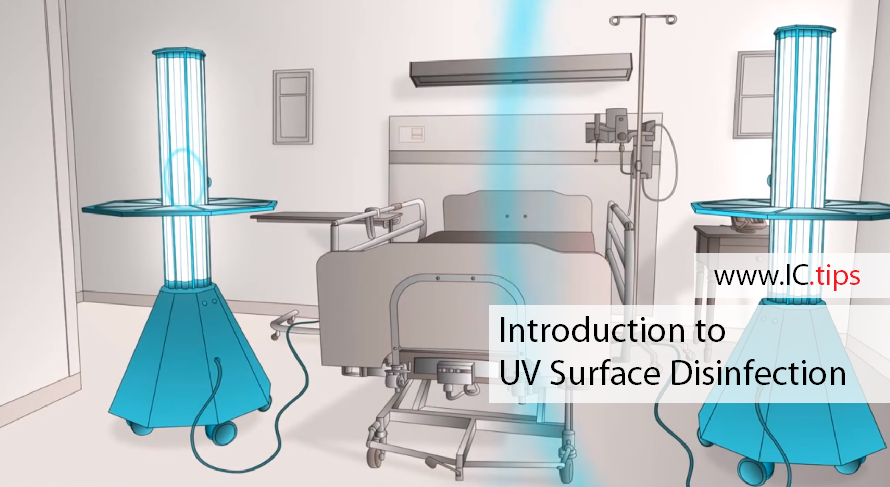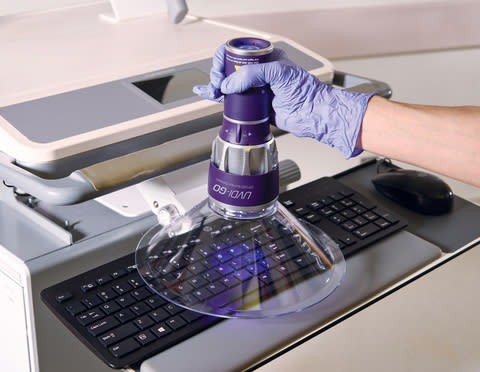Introducing the Advantages of UV Disinfection: Making Sure Tidy and Sanitized Spaces
While standard cleaning methods have actually long been counted upon, improvements in technology have introduced an innovative remedy that makes sure tidy and disinfected areas: UV disinfection. Additionally, we will delve right into the safety and security factors to consider that must be taken right into account when executing UV sanitation. Prepare to discover a brand-new measurement of cleanliness and uncover the untapped capacity of UV disinfection.

The Scientific Research Behind UV Disinfection
UV sanitation is a scientifically proven method that makes use of ultraviolet light to eliminate harmful microorganisms from surface areas and water. The science behind UV sanitation lies in the ability of UV-C light to damage the DNA and RNA of microbes, rendering them not able to reproduce and triggering their ultimate death. UV-C light falls within the wavelength series of 200 to 280 nanometers, which is very efficient in ruining bacteria, viruses, and various other virus.
When exposed to UV-C light, the hereditary material of microbes takes in the energy from the light, leading to the formation of thymine dimers. These dimers interrupt the regular duplication and transcription procedures of the microorganisms, hindering their capability to reproduce and endure (uv surface disinfection). The DNA and RNA damages triggered by UV-C light is dangerous to the bacteria, making UV disinfection a trusted and effective method for killing a vast array of virus
UV sanitation is particularly useful in atmospheres where typical chemical anti-bacterials may be impractical or ineffective. It is a non-chemical approach that does not leave any kind of deposits or damaging spin-offs, making it risk-free for use in food processing, healthcare centers, water treatment plants, and different other industries. Moreover, UV sanitation is ecologically friendly, as it does not add to the growth of antibiotic-resistant germs or various other hazardous toxins.
Performance of UV Sanitation on Virus
The effectiveness of UV sanitation in removing pathogens has been extensively studied and shown in numerous scientific research studies. UV radiation has the capacity to inactivate a vast array of microorganisms, consisting of fungi, germs, and infections, by harming their DNA or RNA. This avoids them from replicating and causing infections.
One study released in the American Journal of Infection Control located that UV disinfection was efficient in reducing the existence of numerous drug-resistant microorganisms in medical facility spaces. Another research performed by the National Institute for Occupational Safety and security and Wellness demonstrated that UV sanitation had the ability to get rid of 99.9% of the influenza infection on surface areas.
UV disinfection has actually likewise shown pledge in combating the spread of healthcare-associated infections (HAIs) According to a research study released in The Lancet, the usage of UV-C light in enhancement to common cleansing procedures considerably reduced the incidence of HAIs in a hospital setting.
Moreover, UV disinfection has actually verified to be effective versus arising virus, such as the extreme intense respiratory disorder coronavirus 2 (SARS-CoV-2), which triggers COVID-19. A research study carried out by the National Emerging Contagious Diseases Laboratories showed that UV-C light can inactivate the infection on surface areas within secs.
Applications of UV Disinfection in Various Settings
With its tested efficiency in eliminating microorganisms, UV disinfection has actually found applications in a range of setups. One of one of the most typical areas where UV disinfection is used is in health care centers. UV innovation is made use of to sanitize person spaces, operating rooms, and various other high-touch surfaces, decreasing the threat of healthcare-associated infections. On top of that, UV sanitation is also being executed in food processing plants and dining establishments to guarantee the safety and security of food products and prevent the spread of foodborne health problems. UV disinfection is additionally beneficial in water therapy plants, where it is utilized to eliminate dangerous microbes and give risk-free drinking water.
An additional vital application of UV disinfection is see this website in the air filtration industry. UV air purifiers are used in household, industrial, and industrial settings to get rid of air-borne microorganisms, viruses, and mold spores. This modern technology is especially valuable in atmospheres where people are more at risk to respiratory moved here system infections, such as healthcare facilities, schools, and office complex.
Furthermore, UV sanitation is increasingly being made use of in mass transit systems, such as buses and trains, to maintain tidy and sanitized rooms for travelers. UV light is employed to decontaminate surfaces and air inside the lorries, reducing the threat of spreading out contagious illness.
Benefits of UV Disinfection Over Conventional Approaches
In contrast to traditional techniques, UV sanitation offers a series of unique advantages that make it a more effective selection in various markets and setups. One considerable benefit is its efficiency versus a wide variety of microorganisms, including fungi, infections, and microorganisms. Unlike chemical anti-bacterials that might have limited efficacy versus certain pathogens, UV disinfection is a non-selective process that can kill or suspend a broad spectrum of harmful organisms.
An additional benefit of UV sanitation is its capacity to provide rapid and effective sanitation. Conventional sanitation techniques commonly require longer contact times or numerous steps to accomplish the desired degree of disinfection. On the other hand, UV light can give prompt and continual sanitation, decreasing downtime and raising productivity in different applications.
UV sanitation additionally supplies a risk-free and eco friendly choice to traditional disinfection approaches. uv surface disinfection. Unlike chemical representatives, UV light does not leave behind any type of hazardous deposits or byproducts, making it ideal for usage in delicate settings such as food processing centers, health care setups, and water treatment plants
Furthermore, UV sanitation is an economical remedy over time. While the in advance investment for UV disinfection systems might be greater than conventional techniques, the operational prices are typically lower. UV lights have a long life expectancy and call for minimal maintenance, leading to reduced labor and substitute prices.
Safety And Security Considerations for UV Disinfection
Considering the possible threats related to UV sanitation, it is vital to address the safety factors to consider entailed in applying this modern technology. UV sanitation uses ultraviolet light to eliminate or inactivate microorganisms, making it an efficient technique for disinfecting numerous surfaces and objects. It is vital to recognize that UV radiation can likewise posture threats to human health if appropriate security measures are not complied with.
Most importantly, direct exposure to UV radiation can trigger harm to the skin and eyes. Prolonged exposure can bring about sunburn, skin damage, and also a boosted risk of creating skin cancer cells. For that reason, it is vital to guarantee that UV sanitation systems are appropriately enclosed and equipped with security functions such as automated shut-off mechanisms or motion sensors to prevent unintended direct exposure.

In addition, proper training and education are important for those in charge of running UV sanitation systems. They need to know the prospective threats, comprehend the safety methods, and recognize exactly how to handle and preserve the devices appropriately.
Conclusion
UV disinfection can be used in numerous settings, consisting of medical care facilities, food handling plants, and water therapy systems. Contrasted to typical methods, UV sanitation has advantages such as faster sanitation times, very little chemical usage, and no dangerous results.
UV sanitation is a scientifically tested approach that makes use of ultraviolet light to remove unsafe bacteria from surface areas and water. The DNA and RNA damages caused by UV-C light is anchor deadly to the microbes, making UV disinfection a effective and reputable approach for killing a broad range of pathogens.
One more benefit of UV sanitation is its ability to provide efficient and rapid sanitation. UV disinfection utilizes ultraviolet light to eliminate or inactivate bacteria, making it a reliable technique for sanitizing numerous surfaces and items. Contrasted to traditional approaches, UV sanitation has advantages such as faster sanitation times, marginal chemical usage, and no dangerous byproducts.